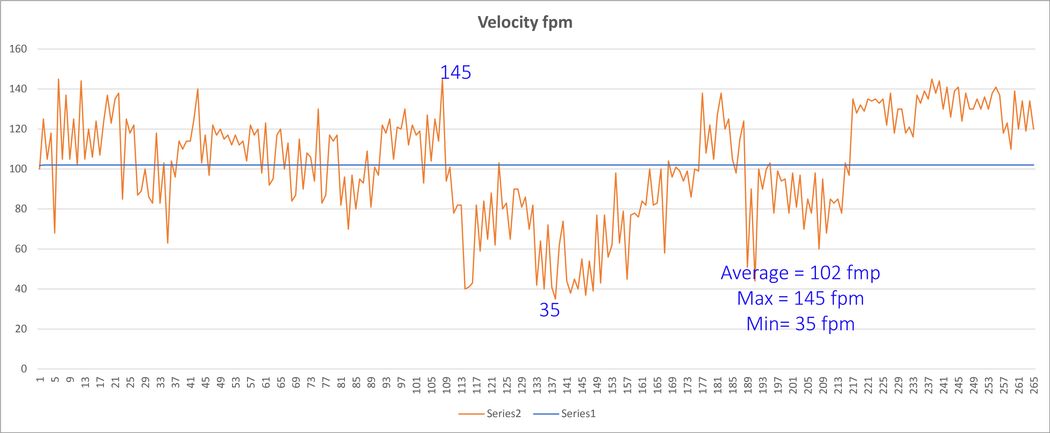Ensuring the safety of laboratory environments is paramount, and one critical aspect is fume hood performance. Traditionally, the safety and efficiency of fume hoods have been gauged using average face velocity readings. However, our data suggests that this method may be insufficient and potentially misleading. Most standards also acknowledge that face velocity doesn’t have a direct relationship with containment. In fact, approximately 70 percent of hoods that fail containment tests still exhibit acceptable face velocities. This statistic underscores the importance of focusing on containment rather than just face velocity.
Limitations in average face velocity
Knowing that air is a fluid and follows the laws of fluid dynamics, you can compare it to water. Just like water runs downhill, air moves from high pressure areas to lower pressure areas. Face velocity is a measurement of how fast it is flowing, although it does not indicate the direction of flow.
Face velocity is the speed at which air enters or exits the fume hood's sash opening. It has been the go-to metric for determining whether a fume hood is operating correctly with the assumption that a certain average face velocity equates to adequate containment of hazardous substances. However, this assumption has been increasingly questioned.
The ASHRAE 110 Tracer Gas test requires you to take a 20-second reading to determine average face velocity. However, we expanded this to 300 seconds and found potential flaws in relying on average face velocity.

Credit: Chip Albright
Chart 1 shows that the average is 102fpm and this is likely what you would see on your hood’s face velocity monitor. Yet there were periods where the velocity was as high as 145 fpm and as low as 35 fpm, both of which are likely unsafe.
These velocity changes mimic the differential pressure changes, which are an indication of turbulence and instability. In these periods of instability are the highest probability for loss of containment.
With the ASHRAE 110 standard only calling for a 20-second reading, the average face velocity could vary wildly depending on which 20-second window is chosen This variance raises serious questions about the reliability of average readings.
This approach not only enhances safety but also provides a stronger defense in the event of legal scrutiny.
To truly understand a fume hood's performance, it is essential to conduct a more extended and detailed assessment. For example, we use laser visualization and SF6 simultaneously to confirm containment.
Using the ASHRAE 110 protocol, we performed an extensive face velocity profile with the collection time expanded from 20 seconds to 300 seconds for each grid cell. This calculation yielded a very different average face velocity, and we saw more variation from cell to cell.
Lastly, we reviewed each cell to see if the average was within +/- 10 percent of the overall average. If not, it was marked problematic and was 12 times likely to have loss of containment when the hood was subjected to typical dynamic challenges.
A five-minute per cell face velocity profile was more accurate in predicting containment.
Containment is more shifting differential pressure and turbulence while face velocity is just one of the components. Room conditions and user actions have much more to do with containment than does face velocity.
To truly understand a fume hood's performance, it is essential to conduct a more extended and detailed assessment.
The full face velocity profile that the above data was extracted from reveals significant turbulence within the fume hood, leading to unstable airflows. Such instability suggests a high probability of containment loss during the five-minute period. Turbulence can cause hazardous fumes to escape, posing risks to laboratory personnel. Therefore, average face velocity alone is not a reliable metric for determining fume hood performance and safety.
The primary purpose of a fume hood is to contain hazardous substances and prevent exposure to lab personnel and contamination of lab air. It is an exposure control device. As noted in many standards, there is no direct correlation between face velocity and containment. Certifying a hood as safe based on fluctuating data could have severe consequences. In the event of an accident or under legal scrutiny, justifying the determination of the hood's safety based on inconsistent face velocity readings would be challenging. Laboratories must consider the potential liabilities and ensure that their safety assessments are robust and defensible.
The assessment of fume hood safety is a critical aspect of laboratory management. By adopting a five-minute per cell face velocity profile and focusing on containment, lab staff can achieve a more accurate and reliable evaluation of fume hood performance. This approach not only enhances safety but also provides a stronger defense in the event of legal scrutiny. As we continue to prioritize the safety of laboratory personnel, it is crucial to embrace more comprehensive and accurate methods of assessing fume hood performance.










